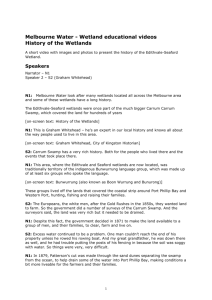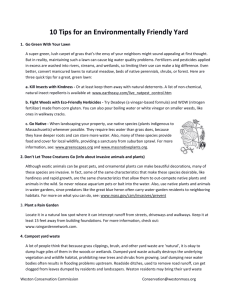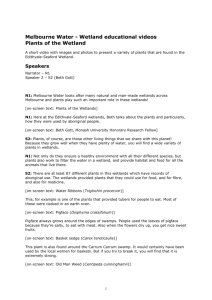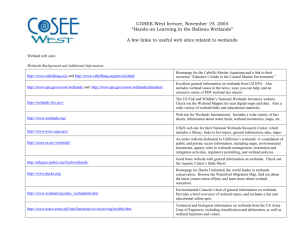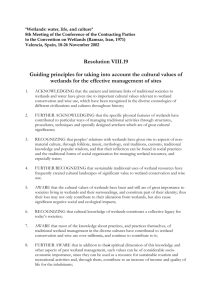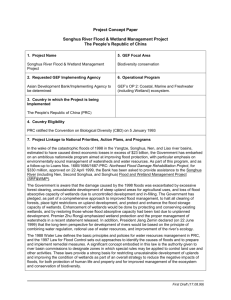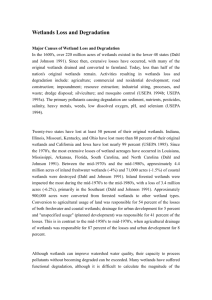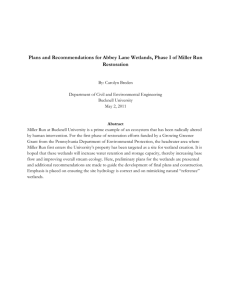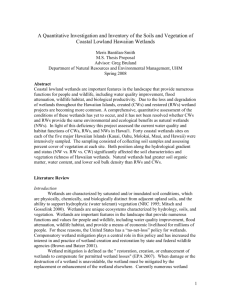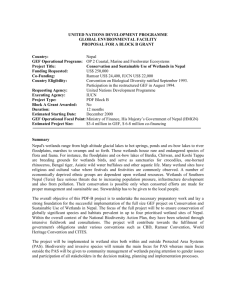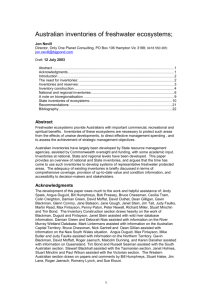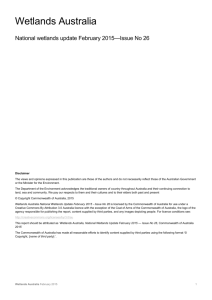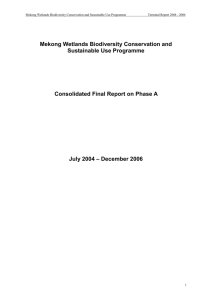Wetland assessment report template 2015
advertisement
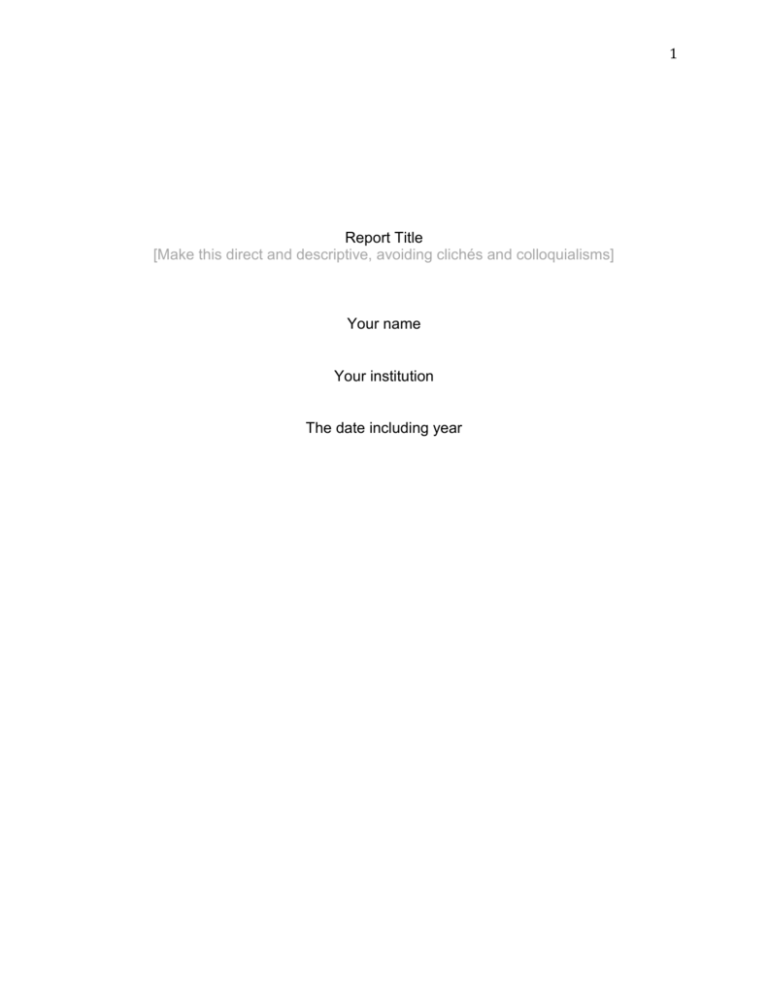
1 Report Title [Make this direct and descriptive, avoiding clichés and colloquialisms] Your name Your institution The date including year 2 Executive Summary [The executive summary provides an overview of only the most essential information. It is to be read by people with no time to digest the whole report including decision makers. Your executive summary must thus be informative, clear and succinct. It should briefly outline the topic of the report, the background issues, the scope of the study, method(s) of analysis, the most important findings, conclusion and recommendations. This should not simply be an outline of the points to be covered in the report with no detail of the analysis done or conclusions reached. 300 words maximum] 3 Introduction [This section provides context, background and at the end a clear statement of the objectives. You could begin with one or two paragraphs discussing broadly the general importance of wetlands in ecosystem functioning, ecosystem services, housing biodiversity etc. This could be followed by a brief discussion of the conflict between human development and agriculture or aquaculture, and the loss of wetlands worldwide. In a subsequent paragraph, discuss the Canadian and particularly the Ontario context in terms of water resources, wetlands and wetland loss, and conservation. In another paragraph, you should introduce QUBS, its size, geographic and ecological context. Finally you should create your statement(s) of objectives. Be sure to use citations from the primary literature of governmental or NGO reports for all major points. This section should be 3-4 pages or 900 – 1200 words total] 4 Materials & Methods [This section provides clear information on choice of sampling locales (both how locales were chosen and where they are situated - e.g. “We chose eight wetlands to represent the range of wetland types present at QUBS, ranging from large lacustrine wetlands to small upland marshes …). It would be well to include an appendix of wetland names and coordinates in an Appendix. You would then outline how these were surveyed and what variables were measured (e.g. “Each of eight student groups comprised of 4 to 5 members were assigned a single wetland. Wetlands were surveyed on two separate days, 5 August 2015, and 6 August 2015 from 6:00 am EST to approximately 17:00 EST. We measured a series of biotic and abiotic variables associated with both the wetland and with the surrounding terrestrial matrix (see Table X)). If you intend to focus on your particular wetland, then you should state that clearly here. Mention all instruments that you used where relevant (e.g. pH meter, densiometre, GPS model). Finally if you do summary statistics across wetlands then clearly state which you estimated and which program you used. Use tables, maps or appendices where relevant. This section should be concise and probably no more than 600 words or two pages double-spaced 12 point font. You may wish to present the scoring sheet that we sent you as an appendix] 5 Results [Here you must walk the reader through your findings in a logical and concise manner. You may wish to include tables and figures to summarize your data so that you can save space but you must still refer to these in the Results section. For example you might say something like “Survey wetlands varied from X to Y hectares in area, and included lacustrine and palustrine marshes, beaver swamps and meadows, and upland wetlands (Table 2).” If you report mean values for some metrics be sure to include measures of variability as well (e.g. standard deviation or range). Your Results section will probably not exceed two pages or approximately 600 words, excluding tables and figures.] 6 Discussion [This section is, in essence, the inverse of your Introduction in that you should start with the specifics of your study and then broaden out into a discussion of the importance of wetlands in Canada and globally, and the relevance of QUBS wetlands to this objective. You should be sure to interpret these patterns and wetlands relative to other wetlands in Ontario, citing the relevant literature of course. Thus, be sure to refer to (and cite properly) other studies that have assessed wetlands. If relevant you should refer back to figures and tables. At the end of this you should draw the Report to a close with a series of concluding statements – either simply as the ultimate paragraph here or if you wish as a separate section entitled “Conclusion.” You should be creative of course and not simply regurgitate what I have written here. This section should be 3-5 pages double-spaced or 900-1500 words total.] 7 Literature cited [This section provides the full references for all of the articles that you cite in the main text. In the body of your report be sure to cite all relevant points – on other words this is not a Bibliography but rather a list of the articles, book chapters and other materials that you actively cite in your work. The number of citations will depend on the thoroughness of your research but should include minimally 10 papers from the primary literature. Please follow the citation style of the journal Ecological Applications. Here are some examples: Journal articles: Barbier, S., F. Gosselin, and P. Balandier. 2008. Influence of tree species on understory vegetation diversity and mechanisms involved — a critical review for temperate and boreal forests. Forest Ecology and Management 254:1–15. Connell, J. H. 1978. Diversity in tropical rain forests and Coral Reefs. Science 199:1302–1310. Books: Crooks, K. R., and M. Sanjayan, editors. 2006. Connectivity Conservation. Cambridge University Press, New York. Book chapters: Wiens, J. A. 1997. The emerging role of patchiness in conservation biology. Pages 93– 107 in S. T. A. Picket, R. S. Ostfeld, M. Shachak, and G. E. Likens, editors. The 8 ecological basis of conservation: heterogeneity, ecosystems, and biodiversity. Chapman and Hall, New York, New York, USA. Reports: Hollweg, H.-D., et al. 2008. Ensemble simulations over Europe with the regional climate model CLM forced with IPCC AR4 Global Scenarios. Technical Report number 3. Model and Data group, Max Planck Institute for Meteorology, Hamburg, Germany. Be sure to be consistent in your citation style.] 9 Tables and Figures [You have two options here with respect to placement of figures or tables. Either embed them within the main text of the report or simply append them as the last section of your report before the Appendices. All figures and tables should have a legend, and all figures and tables should “stand on their own;” in other words a reader should be able to interpret them without reading the text. On graphs axes should be clearly labeled with units. On maps there should be scale and labels clearly indicating major features of political divisions. On tables all acronyms should be spelled out either in the legend or as a footnote. Again all variables should have the appropriate units and please attend to significant digits. We append examples of a table and figure from one of our papers (Row, J.R., R.J. Brooks, C. MacKinnon, A. Lawson, B.I. Crother, M. White & S.C. Lougheed. 2011. Approximate Bayesian computation reveals the origins of genetic diversity and population structure of foxsnakes. J. Evol. Biol. 24: 2364–2377): 10 Table 1. Sample size (N), expected heterozygosity (He), mean number of alleles (MNA) and allelic richness (AR) for genetic clusters of eastern foxsnakes (Fig. 2) in southwestern Ontario and northwestern Ohio. Standard deviation is given in brackets and populations connected with different letters for He and allelic richness were significantly different. Fis was not significantly different and MNA was not tested. See text for details of tests and Fig. 1 for distribution of populations. Population N He MNA AR Fis GeoBay1 119 0.28(0.13)b 2.41(0.79) 2.05(0.54)b 0.03(0.09) GeoBay2 41 0.36(0.21)ab 2.81(0.75) 2.40(0.66)b -0.02(0.13) Swont1 62 0.59(0.14)ab 4.33(1.61) 3.69(1.07)ab 0.01(0.13) SWont2 134 0.61(0.13)ab 5.50(1.83) 3.97(1.10)ab 0.04(0.05) SWont3 28 0.52(0.14)ab 4.00(1.13) 3.46(0.75)ab 0.05(0.16) SWont4 142 0.53(0.20)ab 4.91(1.73) 3.69(1.27)ab 0.02(0.05) SWont5 28 0.58(0.15)ab 3.83(1.40) 3.43(1.06)ab -0.01(0.16) SWont6 84 0.62(0.11)ab 5.33(1.72) 3.93(0.87)ab 0.12(0.06) SWont7 47 0.50(0.16)ab 4.08(1.50) 3.23(0.94)ab 0.03(0.17) Norfolk 64 0.32(0.19)b 3.25(1.28) 2.51(0.80)b 0.13(0.11) L. Mich 33 0.45(0.22)ab 2.08(1.08) 2.04(1.04)b 0.02(0.18) S. West 27 0.74(0.12)ab 7.25(1.76) 5.96(1.44)a 0.07(0.11) M. West 12 0.61(0.19)ab 4.33(1.40) 4.33(1.61)a 0.03(0.14) N. West 12 0.55(0.25)ab 3.83(1.80) 3.80(1.75)a 0.01(0.18) 11 Figure 1. Current approximate range of foxsnakes (dark grey) based on Ernst and Barbour (1989) and occurrence records from Michigan and Ontario. Grey dots represent locations of one or more samples used in the analyses. Dashed lines circumscribe western foxsnake locations that we pooled for genetic diversity and differentiation analysis.






